PY1102 Lab Report: Analysis of Classical Conditioning Experiment
VerifiedAdded on 2023/03/17
|6
|1319
|71
Report
AI Summary
This lab report analyzes an experiment designed to investigate the influence of classical conditioning on consumer behavior. The study involved 50 participants, divided into experimental and control groups, to assess whether exposure to effective images (stimuli) alongside a target product could increase favorability and purchasing intentions. The report details the experimental design, including the stimuli and responses, and formulates hypotheses based on classical conditioning theory. Data analysis, including descriptive statistics and independent sample t-tests, reveals that while mean favorability and purchasing intention were higher in the experimental group, the differences were not statistically significant. The report discusses the potential reasons for these results, such as the influence of other factors in consumer decision-making, and concludes by accepting the null hypothesis. The report adheres to APA 6th edition formatting and provides references to relevant literature on classical conditioning and consumer behavior.
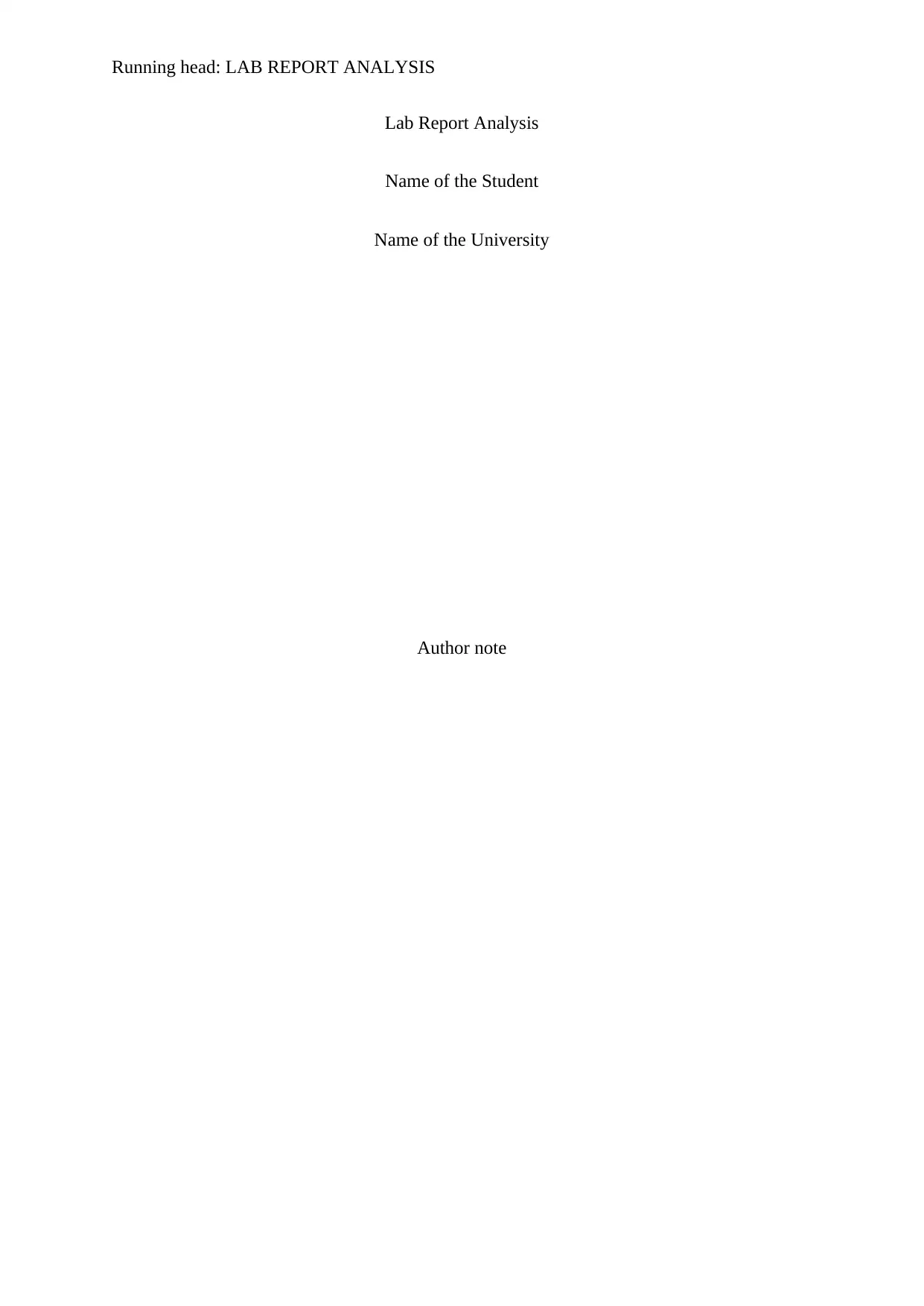
Running head: LAB REPORT ANALYSIS
Lab Report Analysis
Name of the Student
Name of the University
Author note
Lab Report Analysis
Name of the Student
Name of the University
Author note
Paraphrase This Document
Need a fresh take? Get an instant paraphrase of this document with our AI Paraphraser
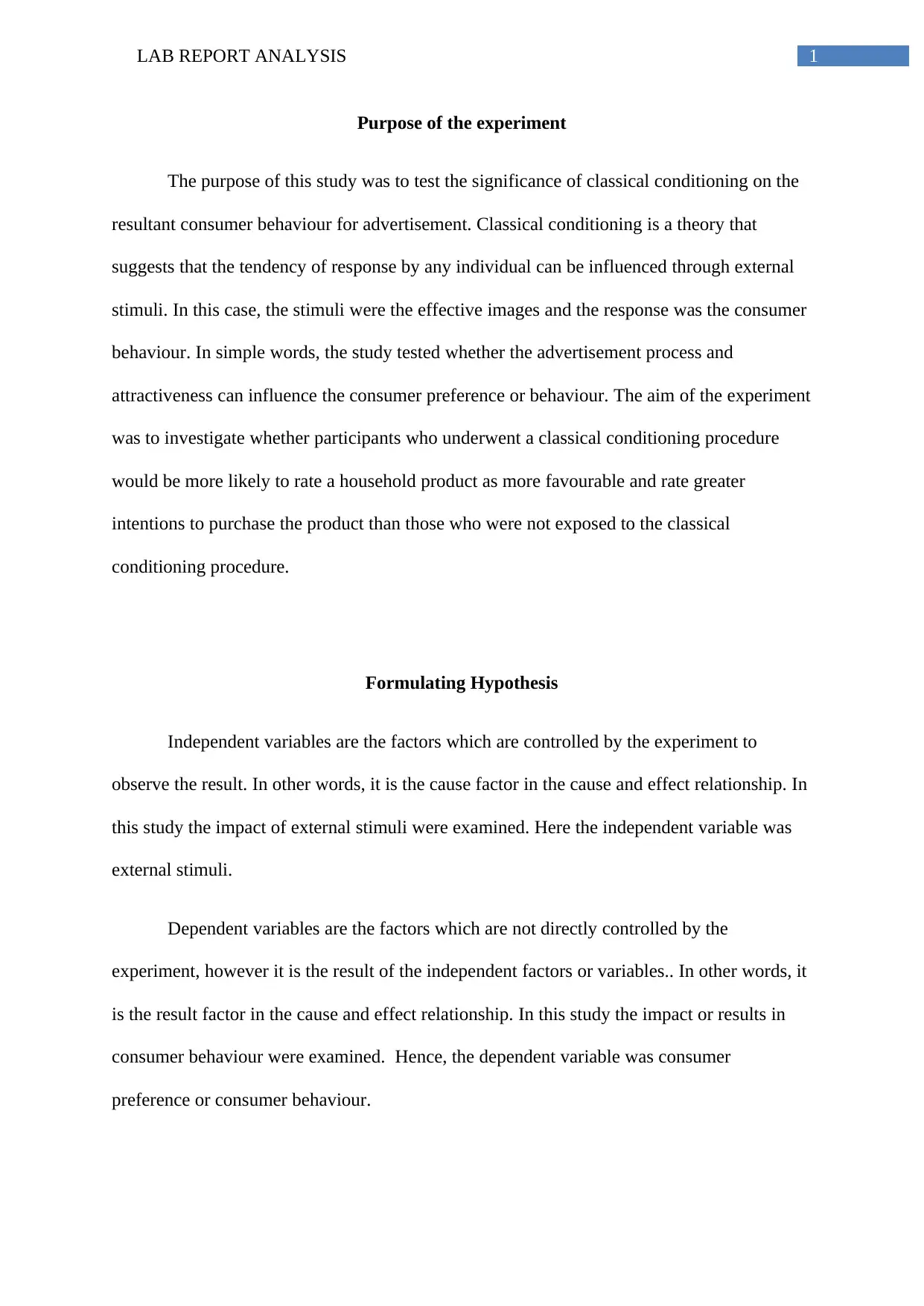
1LAB REPORT ANALYSIS
Purpose of the experiment
The purpose of this study was to test the significance of classical conditioning on the
resultant consumer behaviour for advertisement. Classical conditioning is a theory that
suggests that the tendency of response by any individual can be influenced through external
stimuli. In this case, the stimuli were the effective images and the response was the consumer
behaviour. In simple words, the study tested whether the advertisement process and
attractiveness can influence the consumer preference or behaviour. The aim of the experiment
was to investigate whether participants who underwent a classical conditioning procedure
would be more likely to rate a household product as more favourable and rate greater
intentions to purchase the product than those who were not exposed to the classical
conditioning procedure.
Formulating Hypothesis
Independent variables are the factors which are controlled by the experiment to
observe the result. In other words, it is the cause factor in the cause and effect relationship. In
this study the impact of external stimuli were examined. Here the independent variable was
external stimuli.
Dependent variables are the factors which are not directly controlled by the
experiment, however it is the result of the independent factors or variables.. In other words, it
is the result factor in the cause and effect relationship. In this study the impact or results in
consumer behaviour were examined. Hence, the dependent variable was consumer
preference or consumer behaviour.
Purpose of the experiment
The purpose of this study was to test the significance of classical conditioning on the
resultant consumer behaviour for advertisement. Classical conditioning is a theory that
suggests that the tendency of response by any individual can be influenced through external
stimuli. In this case, the stimuli were the effective images and the response was the consumer
behaviour. In simple words, the study tested whether the advertisement process and
attractiveness can influence the consumer preference or behaviour. The aim of the experiment
was to investigate whether participants who underwent a classical conditioning procedure
would be more likely to rate a household product as more favourable and rate greater
intentions to purchase the product than those who were not exposed to the classical
conditioning procedure.
Formulating Hypothesis
Independent variables are the factors which are controlled by the experiment to
observe the result. In other words, it is the cause factor in the cause and effect relationship. In
this study the impact of external stimuli were examined. Here the independent variable was
external stimuli.
Dependent variables are the factors which are not directly controlled by the
experiment, however it is the result of the independent factors or variables.. In other words, it
is the result factor in the cause and effect relationship. In this study the impact or results in
consumer behaviour were examined. Hence, the dependent variable was consumer
preference or consumer behaviour.
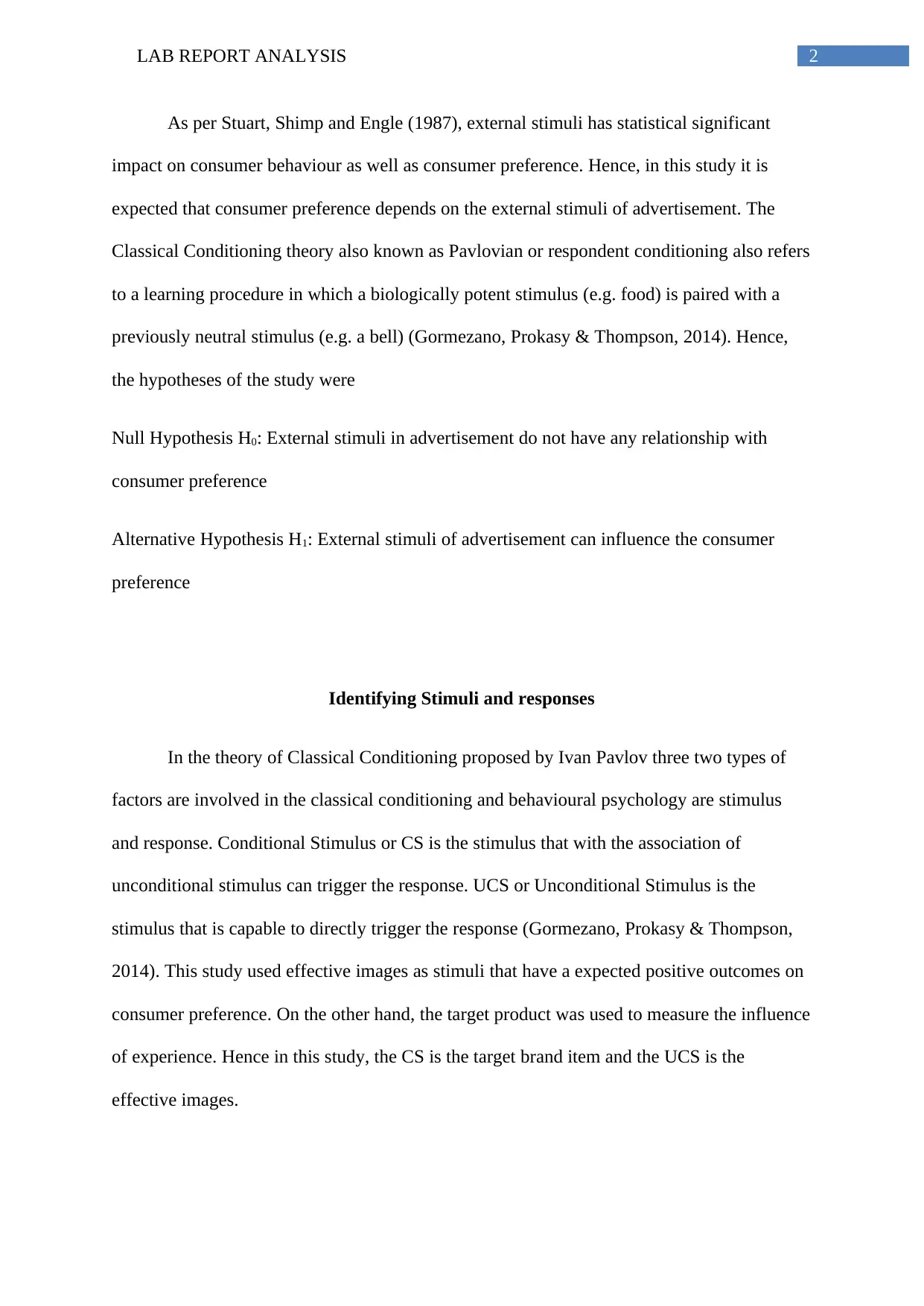
2LAB REPORT ANALYSIS
As per Stuart, Shimp and Engle (1987), external stimuli has statistical significant
impact on consumer behaviour as well as consumer preference. Hence, in this study it is
expected that consumer preference depends on the external stimuli of advertisement. The
Classical Conditioning theory also known as Pavlovian or respondent conditioning also refers
to a learning procedure in which a biologically potent stimulus (e.g. food) is paired with a
previously neutral stimulus (e.g. a bell) (Gormezano, Prokasy & Thompson, 2014). Hence,
the hypotheses of the study were
Null Hypothesis H0: External stimuli in advertisement do not have any relationship with
consumer preference
Alternative Hypothesis H1: External stimuli of advertisement can influence the consumer
preference
Identifying Stimuli and responses
In the theory of Classical Conditioning proposed by Ivan Pavlov three two types of
factors are involved in the classical conditioning and behavioural psychology are stimulus
and response. Conditional Stimulus or CS is the stimulus that with the association of
unconditional stimulus can trigger the response. UCS or Unconditional Stimulus is the
stimulus that is capable to directly trigger the response (Gormezano, Prokasy & Thompson,
2014). This study used effective images as stimuli that have a expected positive outcomes on
consumer preference. On the other hand, the target product was used to measure the influence
of experience. Hence in this study, the CS is the target brand item and the UCS is the
effective images.
As per Stuart, Shimp and Engle (1987), external stimuli has statistical significant
impact on consumer behaviour as well as consumer preference. Hence, in this study it is
expected that consumer preference depends on the external stimuli of advertisement. The
Classical Conditioning theory also known as Pavlovian or respondent conditioning also refers
to a learning procedure in which a biologically potent stimulus (e.g. food) is paired with a
previously neutral stimulus (e.g. a bell) (Gormezano, Prokasy & Thompson, 2014). Hence,
the hypotheses of the study were
Null Hypothesis H0: External stimuli in advertisement do not have any relationship with
consumer preference
Alternative Hypothesis H1: External stimuli of advertisement can influence the consumer
preference
Identifying Stimuli and responses
In the theory of Classical Conditioning proposed by Ivan Pavlov three two types of
factors are involved in the classical conditioning and behavioural psychology are stimulus
and response. Conditional Stimulus or CS is the stimulus that with the association of
unconditional stimulus can trigger the response. UCS or Unconditional Stimulus is the
stimulus that is capable to directly trigger the response (Gormezano, Prokasy & Thompson,
2014). This study used effective images as stimuli that have a expected positive outcomes on
consumer preference. On the other hand, the target product was used to measure the influence
of experience. Hence in this study, the CS is the target brand item and the UCS is the
effective images.
⊘ This is a preview!⊘
Do you want full access?
Subscribe today to unlock all pages.

Trusted by 1+ million students worldwide
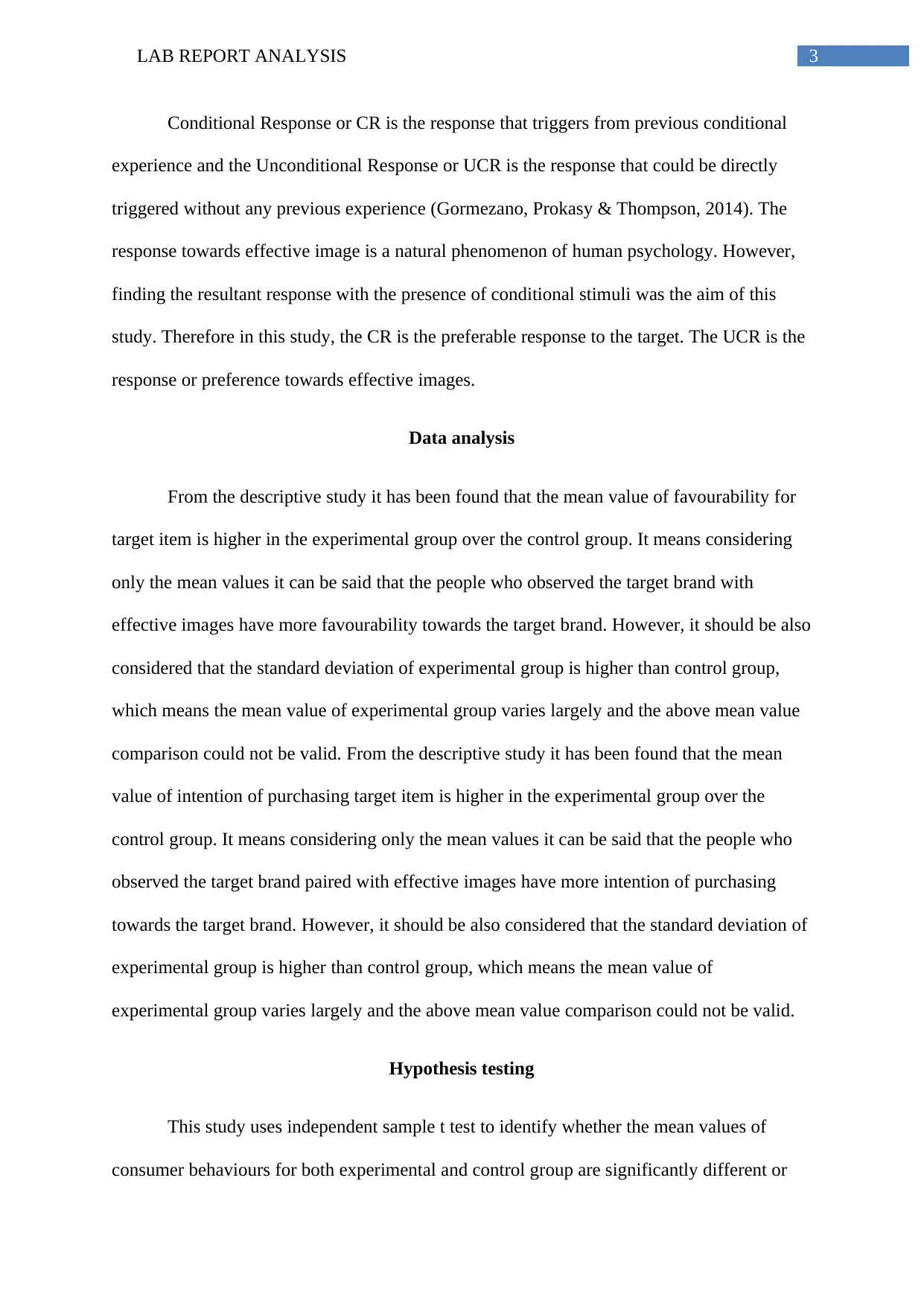
3LAB REPORT ANALYSIS
Conditional Response or CR is the response that triggers from previous conditional
experience and the Unconditional Response or UCR is the response that could be directly
triggered without any previous experience (Gormezano, Prokasy & Thompson, 2014). The
response towards effective image is a natural phenomenon of human psychology. However,
finding the resultant response with the presence of conditional stimuli was the aim of this
study. Therefore in this study, the CR is the preferable response to the target. The UCR is the
response or preference towards effective images.
Data analysis
From the descriptive study it has been found that the mean value of favourability for
target item is higher in the experimental group over the control group. It means considering
only the mean values it can be said that the people who observed the target brand with
effective images have more favourability towards the target brand. However, it should be also
considered that the standard deviation of experimental group is higher than control group,
which means the mean value of experimental group varies largely and the above mean value
comparison could not be valid. From the descriptive study it has been found that the mean
value of intention of purchasing target item is higher in the experimental group over the
control group. It means considering only the mean values it can be said that the people who
observed the target brand paired with effective images have more intention of purchasing
towards the target brand. However, it should be also considered that the standard deviation of
experimental group is higher than control group, which means the mean value of
experimental group varies largely and the above mean value comparison could not be valid.
Hypothesis testing
This study uses independent sample t test to identify whether the mean values of
consumer behaviours for both experimental and control group are significantly different or
Conditional Response or CR is the response that triggers from previous conditional
experience and the Unconditional Response or UCR is the response that could be directly
triggered without any previous experience (Gormezano, Prokasy & Thompson, 2014). The
response towards effective image is a natural phenomenon of human psychology. However,
finding the resultant response with the presence of conditional stimuli was the aim of this
study. Therefore in this study, the CR is the preferable response to the target. The UCR is the
response or preference towards effective images.
Data analysis
From the descriptive study it has been found that the mean value of favourability for
target item is higher in the experimental group over the control group. It means considering
only the mean values it can be said that the people who observed the target brand with
effective images have more favourability towards the target brand. However, it should be also
considered that the standard deviation of experimental group is higher than control group,
which means the mean value of experimental group varies largely and the above mean value
comparison could not be valid. From the descriptive study it has been found that the mean
value of intention of purchasing target item is higher in the experimental group over the
control group. It means considering only the mean values it can be said that the people who
observed the target brand paired with effective images have more intention of purchasing
towards the target brand. However, it should be also considered that the standard deviation of
experimental group is higher than control group, which means the mean value of
experimental group varies largely and the above mean value comparison could not be valid.
Hypothesis testing
This study uses independent sample t test to identify whether the mean values of
consumer behaviours for both experimental and control group are significantly different or
Paraphrase This Document
Need a fresh take? Get an instant paraphrase of this document with our AI Paraphraser
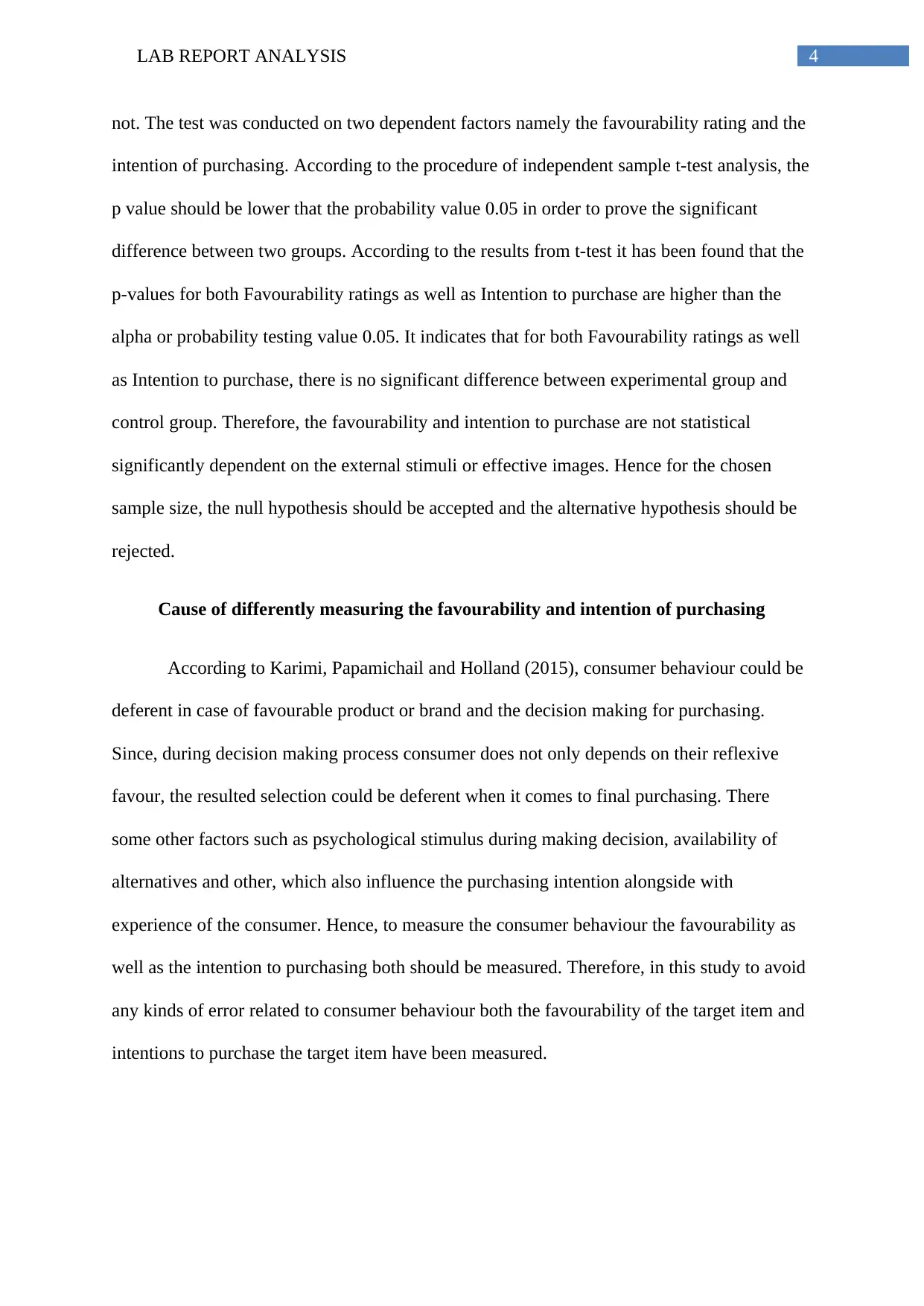
4LAB REPORT ANALYSIS
not. The test was conducted on two dependent factors namely the favourability rating and the
intention of purchasing. According to the procedure of independent sample t-test analysis, the
p value should be lower that the probability value 0.05 in order to prove the significant
difference between two groups. According to the results from t-test it has been found that the
p-values for both Favourability ratings as well as Intention to purchase are higher than the
alpha or probability testing value 0.05. It indicates that for both Favourability ratings as well
as Intention to purchase, there is no significant difference between experimental group and
control group. Therefore, the favourability and intention to purchase are not statistical
significantly dependent on the external stimuli or effective images. Hence for the chosen
sample size, the null hypothesis should be accepted and the alternative hypothesis should be
rejected.
Cause of differently measuring the favourability and intention of purchasing
According to Karimi, Papamichail and Holland (2015), consumer behaviour could be
deferent in case of favourable product or brand and the decision making for purchasing.
Since, during decision making process consumer does not only depends on their reflexive
favour, the resulted selection could be deferent when it comes to final purchasing. There
some other factors such as psychological stimulus during making decision, availability of
alternatives and other, which also influence the purchasing intention alongside with
experience of the consumer. Hence, to measure the consumer behaviour the favourability as
well as the intention to purchasing both should be measured. Therefore, in this study to avoid
any kinds of error related to consumer behaviour both the favourability of the target item and
intentions to purchase the target item have been measured.
not. The test was conducted on two dependent factors namely the favourability rating and the
intention of purchasing. According to the procedure of independent sample t-test analysis, the
p value should be lower that the probability value 0.05 in order to prove the significant
difference between two groups. According to the results from t-test it has been found that the
p-values for both Favourability ratings as well as Intention to purchase are higher than the
alpha or probability testing value 0.05. It indicates that for both Favourability ratings as well
as Intention to purchase, there is no significant difference between experimental group and
control group. Therefore, the favourability and intention to purchase are not statistical
significantly dependent on the external stimuli or effective images. Hence for the chosen
sample size, the null hypothesis should be accepted and the alternative hypothesis should be
rejected.
Cause of differently measuring the favourability and intention of purchasing
According to Karimi, Papamichail and Holland (2015), consumer behaviour could be
deferent in case of favourable product or brand and the decision making for purchasing.
Since, during decision making process consumer does not only depends on their reflexive
favour, the resulted selection could be deferent when it comes to final purchasing. There
some other factors such as psychological stimulus during making decision, availability of
alternatives and other, which also influence the purchasing intention alongside with
experience of the consumer. Hence, to measure the consumer behaviour the favourability as
well as the intention to purchasing both should be measured. Therefore, in this study to avoid
any kinds of error related to consumer behaviour both the favourability of the target item and
intentions to purchase the target item have been measured.
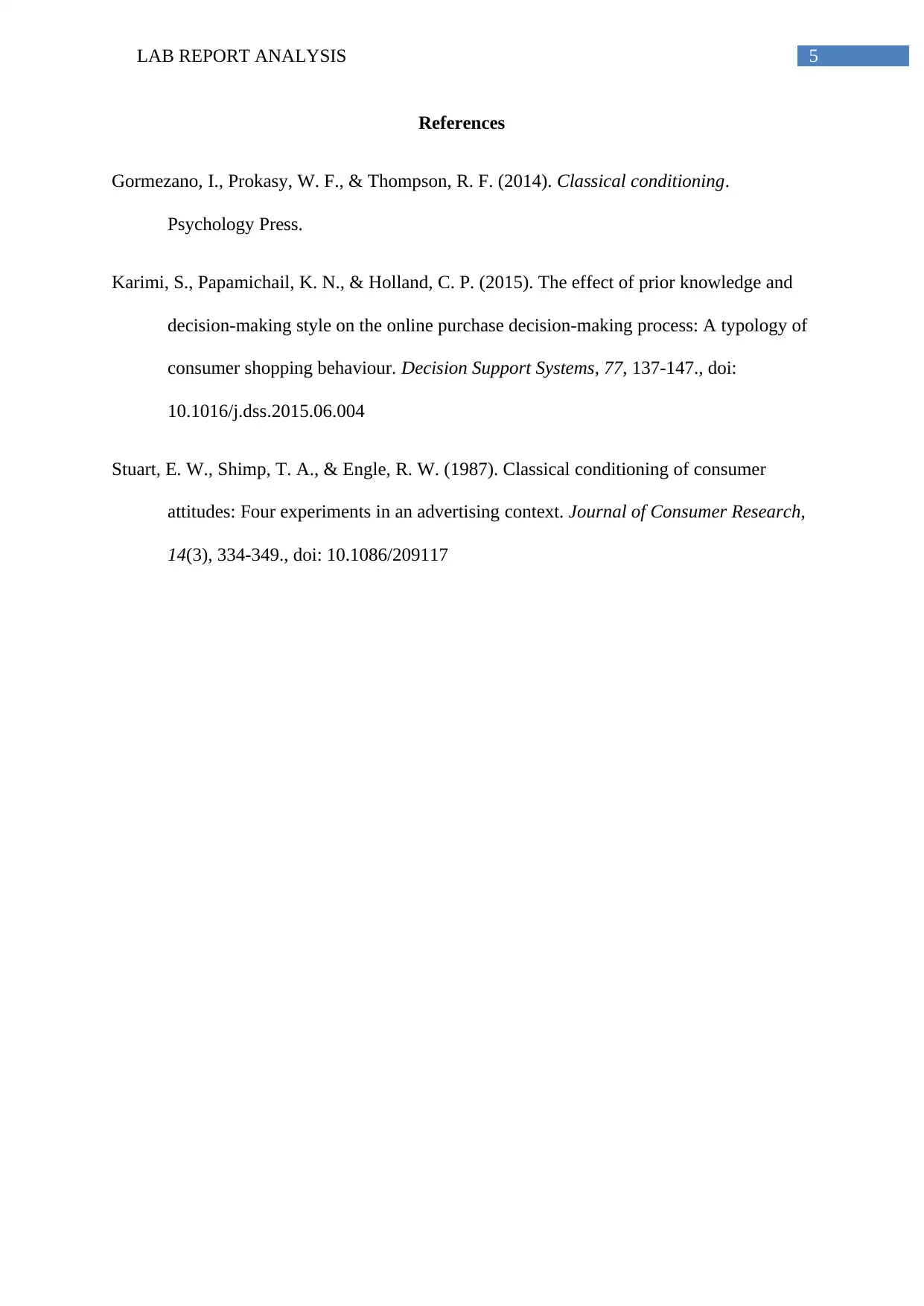
5LAB REPORT ANALYSIS
References
Gormezano, I., Prokasy, W. F., & Thompson, R. F. (2014). Classical conditioning.
Psychology Press.
Karimi, S., Papamichail, K. N., & Holland, C. P. (2015). The effect of prior knowledge and
decision-making style on the online purchase decision-making process: A typology of
consumer shopping behaviour. Decision Support Systems, 77, 137-147., doi:
10.1016/j.dss.2015.06.004
Stuart, E. W., Shimp, T. A., & Engle, R. W. (1987). Classical conditioning of consumer
attitudes: Four experiments in an advertising context. Journal of Consumer Research,
14(3), 334-349., doi: 10.1086/209117
References
Gormezano, I., Prokasy, W. F., & Thompson, R. F. (2014). Classical conditioning.
Psychology Press.
Karimi, S., Papamichail, K. N., & Holland, C. P. (2015). The effect of prior knowledge and
decision-making style on the online purchase decision-making process: A typology of
consumer shopping behaviour. Decision Support Systems, 77, 137-147., doi:
10.1016/j.dss.2015.06.004
Stuart, E. W., Shimp, T. A., & Engle, R. W. (1987). Classical conditioning of consumer
attitudes: Four experiments in an advertising context. Journal of Consumer Research,
14(3), 334-349., doi: 10.1086/209117
⊘ This is a preview!⊘
Do you want full access?
Subscribe today to unlock all pages.

Trusted by 1+ million students worldwide
1 out of 6
Related Documents
Your All-in-One AI-Powered Toolkit for Academic Success.
+13062052269
info@desklib.com
Available 24*7 on WhatsApp / Email
![[object Object]](/_next/static/media/star-bottom.7253800d.svg)
Unlock your academic potential
Copyright © 2020–2025 A2Z Services. All Rights Reserved. Developed and managed by ZUCOL.





